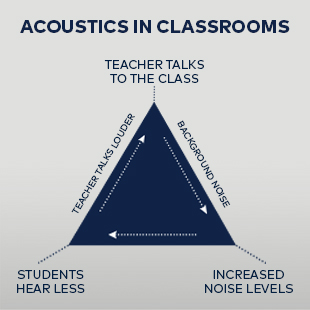Acoustics and lighting in schools – solve two problems at once
Good light and sound are essential for learning. Well-designed classrooms provide both

Everyone remembers a favourite teacher who inspired and motivated them in school. The influence of a great educator can stay with us for life. Less obvious – but just as important – is the effect that school surroundings can have on how we learn. Light is a big element of this, and so is sound.
The right light
In classrooms, students and staff must have adequate light to perform whatever activity they are doing, and must be able to see whiteboards and projector screens. But fundamentally, teaching is all about communication, so lighting must consider face-to-face communication too. The way light falls on people’s faces, known as facial modelling, plays a big role in helping people recognise other and follow what people are saying. For lighting to provide effective facial modelling, it needs to have a good balance of horizontal and cylindrical illuminance at head height, so we can make out the shape of faces clearly, without excessive shadowing. Using luminaires suspended from a ceiling is one way to achieve this.
“Ever struggled to make yourself heard in a busy room? When everyone speaks louder, the background noise only gets worse”
The right acoustics
If good lighting is the first step toward good communication, good acoustics is the next. Ever struggled to make yourself heard in a busy room? The natural response is to speak louder, but if everyone in the room does that, the background noise only gets worse. This is the vicious circle of poor acoustics, which cause echoes that make it hard for us to hear what is being said. Good acoustics, on the other hand, support good communication and learning. The materials used for floors, ceilings and walls all have an effect on the acoustics in a room, as do the light fittings and any other installed equipment. Maximum levels of reverberation are defined in standards including the UK’s Building Bulletin 93 (BB93), Germany’s DIN 18041 and the international standard EN ISO 3382-3.

An ideal solution
Using a luminaire with an acoustic raft can save you the trouble of altering or treating other surfaces in a room, such as concrete ceilings, plasterboard walls or solid wood or vinyl floors, in order to improve acoustics. Thorn’s Arena Symphony LED is an example of an innovative luminaire with sound-absorbing features to minimise echoes, which is fully compliant with European acoustic regulations. Arena Symphony LED is specifically designed to improve sound control in primary and secondary school classrooms, creating quieter, brighter and more comfortable environments for learning.
“Installing the right luminaires to optimise acoustics is a great way to solve two problems at once”
Light and sound – solved
Sound may not be the first thing you have in mind when embarking on a lighting project, but installing the right kind of luminaires to optimise acoustics in a learning space is a great way to solve two problems at once.
